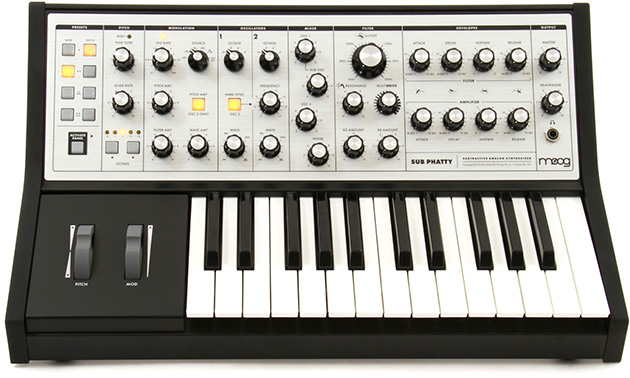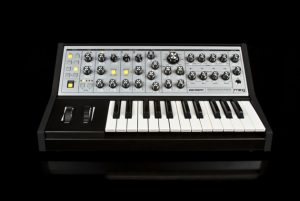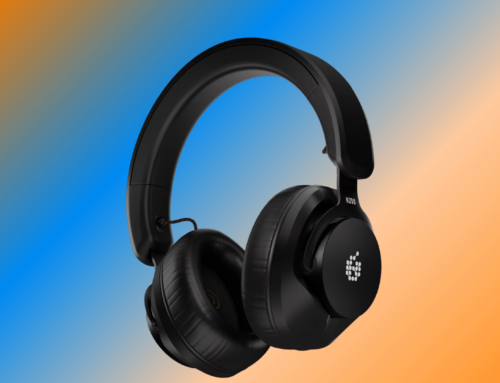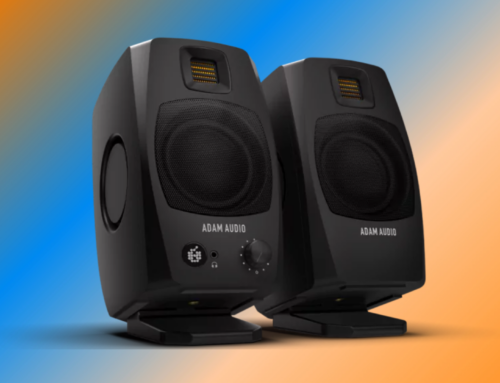 At least among older keyboardists, monophonic, analog synths have gotten greater visibility in recent years. The Cure’s Rodger O’Donnell’s first solo album The Truth in Me (2006) involved the Moog Voyager, while Depeche Mode’s Sounds of the Universe, even as mediocre as the result was, featured some vintage Moogs. The recent winter NAMM had several brands unveiling monophonic analog synths out of demand, with Moog introducing the Sub Phatty at the time.
At least among older keyboardists, monophonic, analog synths have gotten greater visibility in recent years. The Cure’s Rodger O’Donnell’s first solo album The Truth in Me (2006) involved the Moog Voyager, while Depeche Mode’s Sounds of the Universe, even as mediocre as the result was, featured some vintage Moogs. The recent winter NAMM had several brands unveiling monophonic analog synths out of demand, with Moog introducing the Sub Phatty at the time.
This latest fully analog, monophonic synthesizer offers just over two octaves (25 semi-weighted keys, to be precise), 16 presets (four banks with four patches each), pitch and mod wheels, 31 knobs on the front panel, two variable waveshape oscillators, one square wave suboscillator, and one noise generator. While a good deal of these seem standard for a Moog analog device, they’re really the foundation for what’s a solid synth for low-range playing and sound effects.
First, let’s start with the design. While Moog has been advertising this as one of its more “affordable” products (you’ll soon find out you truly get a good bang for your buck), nothing about the design screams “cheap.” In fact, its physical form is very solid and stable, down to the buttons and knobs. Unlike for the Minimoog Voyager, however, a tilting panel is absent, but the device is angled comfortably enough.
What’s particularly different about this analog synth is its two-part aspect, and for the first-time user, that thick, hardcopy manual comes in handy soon enough. So, what are the most upfront aspects?
 The Multidrive, which is two drive circuits, is one of the features everyone has been talking about – and for good reason. The Sub Phatty’s the first analog from Moog to come with this feature, and according to reports, it has been compared to the non-linear drive aspect of some guitar pedals mixed with the quality of a VCA circuit. Perhaps, as well, its most definitive element, Multidrive colors the sound, creating something that, on one end, is warmer and bigger and, doing a 180, gives the Sub Phatty its gritty, aggressive side. It’s extremely reactive in giving pre- and post-filter saturation to the mix, and ultimately, it’s going to lead to a fair amount of experimentation.
The Multidrive, which is two drive circuits, is one of the features everyone has been talking about – and for good reason. The Sub Phatty’s the first analog from Moog to come with this feature, and according to reports, it has been compared to the non-linear drive aspect of some guitar pedals mixed with the quality of a VCA circuit. Perhaps, as well, its most definitive element, Multidrive colors the sound, creating something that, on one end, is warmer and bigger and, doing a 180, gives the Sub Phatty its gritty, aggressive side. It’s extremely reactive in giving pre- and post-filter saturation to the mix, and ultimately, it’s going to lead to a fair amount of experimentation.
The mixer, too, is another one of the more notable “surface” features. Equipped with the suboscillator, its purpose is creating a square wave one octave below the Oscillator 1, essentially being the device’s third oscillator. As another coloring aspect, it’s best for your low-frequency and percussive sounds.
 The oscillators themselves offer pitch ranges of 16’, 8’, 4’, and 2’, with multiple wave shapes and options for changing the character and color of your sound. Specifically, the synth gives the user decent control of linear detuning of the two oscillators (known as Beat Frequency on other analog Moog synths) across the full keyboard.
The oscillators themselves offer pitch ranges of 16’, 8’, 4’, and 2’, with multiple wave shapes and options for changing the character and color of your sound. Specifically, the synth gives the user decent control of linear detuning of the two oscillators (known as Beat Frequency on other analog Moog synths) across the full keyboard.
Along with these basics, the 16 patches, all velocity sensitive, work with the synth’s software editor/library software. While this might seem limiting for some, the software lets users create, edit, and store all sounds.
 Although there are plenty of cool things to do with the “surface” aspects, the lack of digital elements (there is no screen at all) creates a shift mode, which literally opens a whole dimension of possibilities for the Sub Phatty. Sort of like the device’s “Easter eggs,” shift functions get activated when the user goes to one of the banks and presses it simultaneously as the activate panel button.
Although there are plenty of cool things to do with the “surface” aspects, the lack of digital elements (there is no screen at all) creates a shift mode, which literally opens a whole dimension of possibilities for the Sub Phatty. Sort of like the device’s “Easter eggs,” shift functions get activated when the user goes to one of the banks and presses it simultaneously as the activate panel button.
The result, depending upon what you press, expands the physical control possibilities, from reassignments and further parameter adjustments. It’s a bit complex to explain here, and a user is advised – actually, more like required – to thoroughly go through the manual to fully understand all you can do and what you have to press to fully use shift mode.
But, even with all the fancy, new features, the question remains, “What does it sound like?” Overall, it’s unmistakably a Moog product, maintaining its classic sound while still being modern in the process; this is one of those products that, if you’re looking for quality low-range sounds, that works for both modern and vintage uses.
 Along with this, there’s a certain clarity and warmth that other modern and vintage devices don’t have. For convenience, it starts giving this quality right from the get-go; all you really need to do it set and power it up, and the Sub Phatty gives this quality, all while firmly keeping its pitch steady, without any warm up. And, it remains this way even when your studio or performance space heats or goes cold.
Along with this, there’s a certain clarity and warmth that other modern and vintage devices don’t have. For convenience, it starts giving this quality right from the get-go; all you really need to do it set and power it up, and the Sub Phatty gives this quality, all while firmly keeping its pitch steady, without any warm up. And, it remains this way even when your studio or performance space heats or goes cold.
Since this product’s debut, there has been a fair amount of buzz, and you can say it’s all deserved. This is a synth that’s really for everyone: Someone looking to experiment, someone wanting quality low-range gear, someone wanting that vintage sound without having to mess around with out-of-date gear, and someone looking for that combination of good price and good quality.



